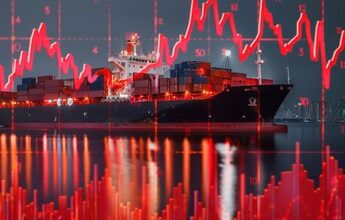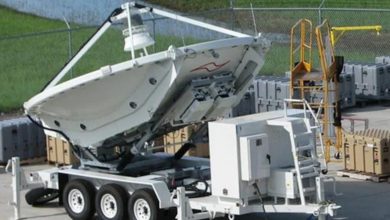Captured Leopard 2 resurfaces at Russia’s main tank factory

BERLIN — Russia has transported a captured Ukrainian Leopard tank deep into its hinterland to tear it down and analyze its components, an open-source investigation by Defense News shows.
Satellite imagery, footage released by Russian media and other open-source information pinpoint the location of the captured 2A6 tank. The factory, Uralvagonzavod – Ural Wagon Factory, in English – is known as the world’s largest tank producer, reportedly having churned out over 100,000 since World War 2. It is also involved in the production of the most modern tank variants Russia has to offer.
The captured tank appeared in good shape once the tarp covering it during its journey was lifted by workers. On the sides of the turret, anti-drone steel screens – colloquially called “cope cages” – were visible. These additions have become standard on the battlefield in Ukraine as a simple defense against explosive-laden kamikaze drones, which can crack armored vehicles when rammed into weak points.
It’s unclear when and where exactly the Leopard tank was captured by Russian forces. Dutch open-source investigative site Onyx, which keeps track of battlefield losses in the Ukraine war, has identified 13 Leopard 2A6 tanks that the Ukrainian armed forces have lost. Seven have been destroyed, while the rest were damaged.
Located in Nizhny Tagil behind Russia’s Ural Mountains, which form the boundary between Europe and Asia, the factory where the Leopard 2 resurfaced is far from the front line in Ukraine. The vehicle was seen arriving at the facility under the cover of darkness on a flatbed truck, video footage reviewed by Defense News showed.
The Ural Wagon Factory, which produces train cars besides armored vehicles, is one of the largest industrial complexes in Russia. It was built in its present location deep inside Russia at Stalin’s behest during World War 2. At the time, the rapid advance of German forces in their surprise “Barbarossa” invasion necessitated the evacuation of vital wartime industries far away from the Western border of Russia, home to most of the country’s population centers.
The location was likely chosen as the destination for the captured 2A6 Leopard because of its institutional knowledge and role as a high-end tank manufacturer in the Russian military-industrial complex, meaning it houses experienced engineers. Media reports from 2023 showed that the state-owned enterprise was responsible for producing Russia’s modern T-90M and the modernization of T-72B3M main battle tanks.
Defense News was able to geolocate video footage of this upgrade process to the same building where the captured Ukrainian Leopard tank was dropped off.
The plant’s importance was underscored by Russian President Vladimir Putin’s visit in February of this year. Russian government press releases have hinted that new production capabilities are being added to Uralvagonzavod, and the factory has switched to an around-the-clock work schedule to increase its output for the war effort in Ukraine.
Sensitive technologies?
Russian media gloated at the capture of the Western tank, citing Western industry publications as panicking about classified technologies falling into Moscow’s hands. Articles further goaded that “the unsuccessful use of German tanks in Ukraine could negatively affect the export potential of armored vehicles,” as RIA Novosti, a Russian state-owned news agency, put it.
Although over 20 years old, the German-made Leopard 2A6 is still regarded as a competent and modern main battle tank. Its advantages over Russian tanks range from higher crew survivability to the advanced gun, fire control system, different armor, type of shells used, and even the powerful and efficient engine.
Despite some media claims, gladly echoed by Russian state-run outlets, it is unclear whether the tanks delivered to Ukraine from Germany contain more sensitive technologies than those that were built for export to other countries. Some analysts expressed concern that because the tanks came from German Bundeswehr stocks, they may have especially advanced systems on board.
KNDS, the tank’s manufacturer, told Defense News that the company was not concerned about the capture of its technology by Russia.
“It won’t be easy to copy, and Russia is likely to have much of the information already anyway,” a company spokesperson said in an interview. The arms manufacturer further clarified that there is no such thing as an “export version” of the tank, but that orders are tailored to their specific customers’ requirements. The spokesperson, who asked to remain unnamed, could not say whether there were particularly sensitive technologies in the tanks coming from the German armed forces or whether they had been modified before being sent to Ukraine.
“The Russians will likely be able to figure out some things — but what exactly, is hard to say,” the company spokesperson concluded.
The German armed forces did not return a reply for clarification and comment on the specifics of the Leopard 2A6 tank in time for publication.
Germany has provided Ukraine with 18 Leopard tanks of the 2A6 variant, while Portugal has contributed three.
This isn’t the first Leopard 2 that Russia has captured. In April, footage was released of Russian military men analyzing a tank in a field tent that was missing its treads. However, the more recently resurfaced tank appears to be in much better condition, possibly providing insights that Russia was unable to gain previously.
Dozens of Western countries, including many in NATO, use the Leopard 2 tank in various configurations. Finland operates 200 Leopard 2 tanks, of which 100 are of the 2A6 variant. Analyzing its capabilities and limitations could assist Russia in furthering its own domestic technologies but could also provide Moscow’s armed forces with a better understanding of how to defend against and destroy the vehicle.
Russian government outlets have repeatedly said that the Western supply to Ukraine amounted to “playing with fire” and directly involved NATO countries in the conflict, a stance that the Euro-American alliance rejects.
Russian Foreign Minister Sergey Lavrov has said any cargo containing weapons for Ukraine would be considered legitimate targets by the Russian military.
Linus Höller is a Europe correspondent for Defense News. He covers international security and military developments across the continent. Linus holds a degree in journalism, political science and international studies, and is currently pursuing a master’s in nonproliferation and terrorism studies.







